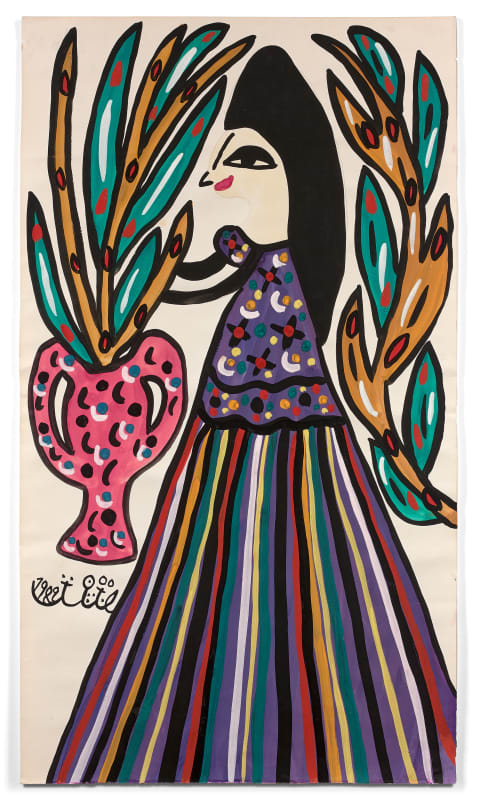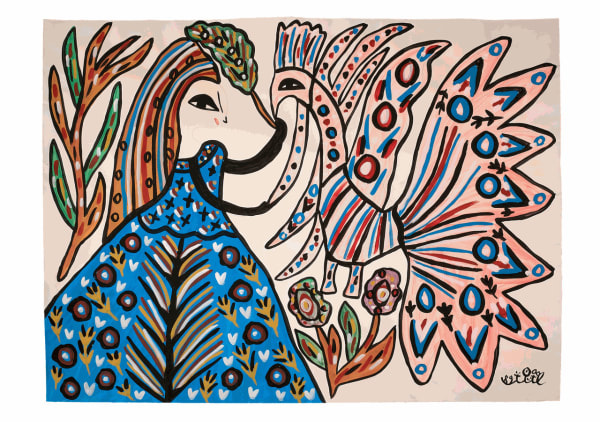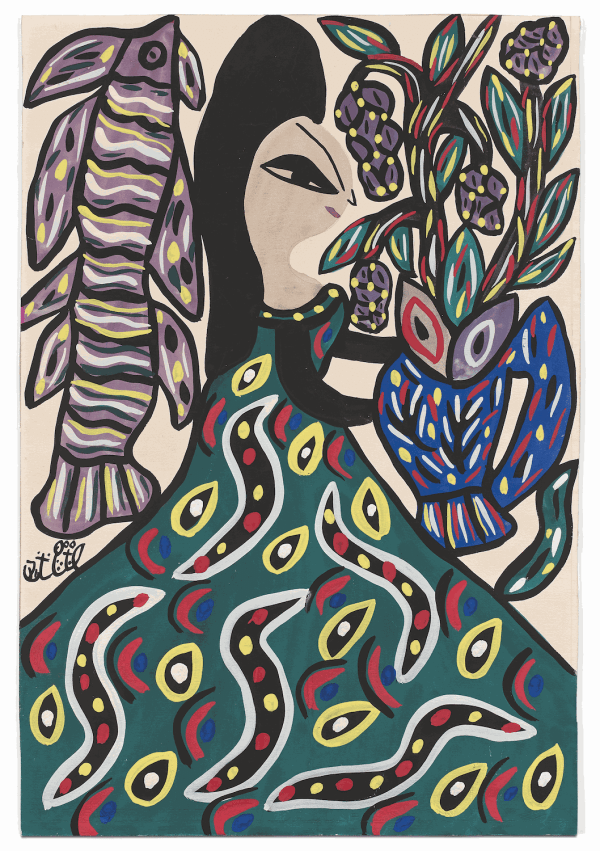Baya Mahieddine Borj El Kifan - Blida, 1931-1998
Overview
Baya’s ground-breaking career as a pioneer woman artist had a profound influence on North African post-colonial art movements during the mid-twentieth century and beyond. With artists like M’Hamed Issiakhem (1928-1985), Abdelkader Guermaz (1919-1996), Mohammed Khadda (1930-1991), Baya is among the most influential artists and a pioneer of Algerian modern art, and like Frida Kahlo, was often associated with the Surrealist movement. Baya took her inspiration primarily from her homeland where she lived and worked. Her dreamlike quality work, rich in symbols and ornamentation was clearly influenced by her Algerian cultural heritage. Orphaned at age five, Baya was drawn to art as an adolescent by observing what she lived with and saw all around her, a mix of Arab and Berber cultures. Baya was highly valued by many of the leading figures of the Parisian avant-garde such as Pablo Picasso, Henri Matisse, and the father of Surrealism, André Breton, who exclaimed enthusiastically: “Baya is queen” in his writings on the young talented woman. Celebrated in Algeria, France, and the Middle East, Baya gained international recognition with her first North American exhibition organized by the Grey Art Gallery at New York University in 2018.
Born in Bordj el-Kiffan in 1931, self-taught Algerian artist Baya Mahieddine, known as Baya, was orphaned at age five living with her father’s family. Later in 1940, she was adopted in Algiers by the French art collector, Marguerite Camina Benoura, formerly married to the British painter Franck Mac Ewen. Encouraged by her adoptive French parents, living in Algeria, to pursue art, she was exposed to Benoura’s collection of modern art, including works by Matisse, and by age nine she was painting and sculpting in clay as well. Her works were soon discovered by the sculptor Jean Peyrissac and legendary French gallerist Aimé Maeght, known for representing Miro, Calder, Leger, Braque, Giacometti and Chagall, who invited her to exhibit for her first solo show in his gallery in Paris in 1947, at the age of sixteen. Andre Breton wrote the preface to the Galerie Maeght’s catalogue. The prestigious publication “Derrière le Miroir” was consecrated to Baya, with texts by Jean Peyrissac and Emile Dermenghem. The colorful, surreal and childlike imagery of her work appealed to leading Parisian figures, including Pablo Picasso, with whom she collaborated in the renowned Madoura ceramics studio in Vallauris in 1949, and traces of her influence can be seen in his Women of Algiers series. Baya and Jean Senac meet up in Algiers. Together, they translated and illustrated poems such as “bwaqel” which were published in Senac’s literary collection “Soleil”. Her work was featured in prestigious publications such as the magazine “Vogue” that consecrated the cover page to her with a text by Edmonde Charles Roux.
In 1953, she married the musician El Hadj Mahfoud Mahieddine and raised a family during a time of revolution in Algeria, but declined an offer to move to France, in affirmation of her Algerian identity. She settled with her family in Blida in Algeria: it's the end of an era. Thanks to the praises of Jean de Maisonseul, who was the director at the Fine Arts National Museum, Baya returns to her studio after a break of ten years. She exhibited in 1963 at the Fine Arts National Museum of Algiers and in 1964 in Paris. She won the 2nd prize of the National Union of Visual Arts (UNAP) in 1971. In 1982, the Museum Cantini in Marseilles organized an exhibition of her work inaugurated by French President François Mitterrand in presence of the Mayor of Algiers and the Minister of Culture, Jack Lang. Baya’s work has been regularly exhibited in Paris in 1984, 1987 and 1991. In 1986, she participated at the 2nd Biennial of La Havana, Cuba. In July 1987, she was honored by Algerian president Chadli. Baya died on November 9, 1998 in Blida. A portrait of Baya and one of her paintings appeared on Algerian postage stamps in 2008. Her works can be found in numerous public and private collections worldwide.
Works
Exhibitions
-

Baya : Femmes, oiseaux, fleurs et luth
Baya Mahieddine (1931 - 1998) 21 Dec 2022 - 29 Jan 2023Coinciding with the exhibition « Baya, icône de la peinture algérienne Femmes en leur Jardin » at the Institut du Monde Arabe in Paris, the gallery is showing a selection...Read more -

Positions and Points of View | Partis Pris et Points de Vue
Group Show 8 Sep - 9 Oct 2022Positions and Points of View By Natasha Boas Ph.D, International Curator Lilia Ben Salah presents Positions and Points of View, the inaugural exhibition of her new gallery centrally located in...Read more
Press
News
-

Présences Arabes - Art moderne et décolonisation Paris, 1908 - 1988
Musée d'Art Moderne de Paris April 3, 2024The exhibition 'Arab Presences - Modern Art and Decolonization Paris, 1908 - 1988', which opened on April 3, 2024 at the Musée d'Art Moderne in...Read more -

"Rien ne me manque" Baya & Czermak Ichti au musée des Beaux-Arts de Nîmes
Première édition de la Contemporaine de Nîmes. Du 5 avril au 10 octobre 2024 April 16, 2024C’est un dialogue artistique intergénérationnel exceptionnel qui prend place au Musée des Beaux-Arts de Nîmes. La jeune peintre Neïla Czermak Ichti expose aux côtés de...Read more










